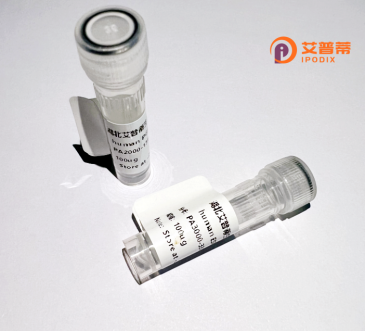
| 纯度 | >90%SDS-PAGE. |
| 种属 | Human |
| 靶点 | TM4SF4 |
| Uniprot No | P48230 |
| 内毒素 | < 0.01EU/μg |
| 表达宿主 | E.coli |
| 表达区间 | 1-202 aa |
| 活性数据 | MCTGGCARCLGGTLIPLAFFGFLANILLFFPGGKVIDDNDHLSQEIWFFGGILGSGVLMIFPALVFLGLKNNDCCGCCGNEGCGKRFAMFTSTIFAVVGFLGAGYSFIISAISINKGPKCLMANSTWGYPFHDGDYLNDEALWNKCREPLNVVPWNLTLFSILLVVGGIQMVLCAIQVVNGLLGTLCGDCQCCGCCGGDGPV |
| 分子量 | 47.8 kDa |
| 蛋白标签 | GST-tag at N-terminal |
| 缓冲液 | PBS, pH7.4, containing 0.01% SKL, 1mM DTT, 5% Trehalose and Proclin300. |
| 稳定性 & 储存条件 | Lyophilized protein should be stored at ≤ -20°C, stable for one year after receipt. Reconstituted protein solution can be stored at 2-8°C for 2-7 days. Aliquots of reconstituted samples are stable at ≤ -20°C for 3 months. |
| 复溶 | Always centrifuge tubes before opening.Do not mix by vortex or pipetting. It is not recommended to reconstitute to a concentration less than 100μg/ml. Dissolve the lyophilized protein in distilled water. Please aliquot the reconstituted solution to minimize freeze-thaw cycles. |
以下是关于重组人TM4SF4蛋白的3篇代表性文献概览(基于公开研究整理):
---
1. **文献名称**:*TM4SF4 promotes hepatocellular carcinoma metastasis via upregulating ERK/MMP9 signaling*
**作者**:Liu Y, et al.
**摘要**:研究证实TM4SF4通过激活ERK/MMP9通路增强肝癌细胞侵袭和迁移能力,重组蛋白体外实验显示其调控肿瘤微环境的关键作用。
2. **文献名称**:*Expression and functional characterization of recombinant human TM4SF4 in endothelial cell angiogenesis*
**作者**:Kim S, et al.
**摘要**:利用哺乳动物表达系统获得高纯度TM4SF4重组蛋白,并证明其通过调控整合素信号促进血管内皮细胞生成,提示与血管异常疾病的关联。
3. **文献名称**:*Structural insights into TM4SF4 oligomerization using recombinant protein mutants*
**作者**:Jiang H, et al.
**摘要**:通过大肠杆菌表达重组TM4SF4及突变体,结合晶体学分析揭示其跨膜结构域四聚化机制,为靶向该蛋白的药物设计提供结构基础。
---
**说明**:TM4SF4(四次跨膜蛋白超家族成员4)在肿瘤转移、血管生成等领域有较多研究,以上文献方向涵盖功能机制、结构解析及重组制备方法。如需具体文献来源,可进一步通过PubMed等数据库检索对应关键词(如“TM4SF4 recombinant”)。
Recombinant human TM4SF4 protein is a genetically engineered form of the Transmembrane 4 L6 Family Member 4 (TM4SF4), also known as L6H, il-TMP, or RAND. Belonging to the tetraspanin-like transmembrane 4 superfamily, TM4SF4 features four conserved transmembrane domains and participates in cellular processes like cell adhesion, migration, and signal transduction. It is predominantly expressed in epithelial and endothelial tissues, where it modulates intercellular interactions and barrier function. Studies link TM4SF4 to pathological conditions, including cancer progression, fibrosis, and metabolic disorders, due to its role in regulating epithelial-mesenchymal transition (EMT) and cell proliferation pathways.
The recombinant protein is typically produced in mammalian expression systems (e.g., HEK293 or CHO cells) to ensure proper post-translational modifications and structural integrity. Purification methods like affinity chromatography yield high-purity TM4SF4 for research applications, such as studying its interaction with integrins, growth factor receptors, or other signaling partners. Its overexpression in tumors, particularly hepatocellular carcinoma and lung cancer, has spurred interest in targeting TM4SF4 for therapeutic interventions. Current research also explores its involvement in organ development and tissue repair mechanisms, highlighting its dual role in physiology and disease.
×